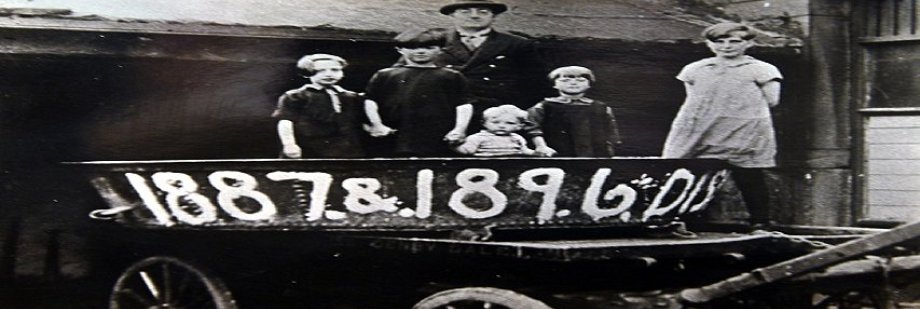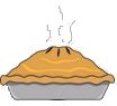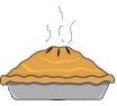
A History Of The Denby Dale Pie
In the late eighteenth century Denby Dale was little more than a scattering of farms on the hillsides, with small groups of cottages clustering in the hollows at Haywood Bottom, Revell Bottom and
Wood Nook.
It was very much a rural community which in 1788 came together to enjoy a holiday and a communal feast in celebration of the recovery of King George III from his terrible mental
affliction.
In his honour a large game pie was baked in an oven at the White Hart Inn, and was cut up and served to the assembled villagers in Cliff Style field nearby.
Unfortunately there was no written record of it’s contents nor of the day’s festivities.
The Victory Pie - 1815
The Napoleonic War was an anxious time as rumours of a French invasion were rife.
The Duke of Wellington’s victory over Napoleon at Waterloo in 1815 brought those fears to an end, and was the occasion of national rejoicing.
Denby Dale joined in those celebrations by making a large pie containing two sheep and twenty fowls, and a massive pastry crust made from half a peck of flour.
This particular pie was baked in an oven at Corn Mill and, as in 1788, was served out to the assembled villagers at a communal feast.
The Repeal of the Corn Laws Pie - 29th August 1846
During the Napoleonic War, British farmers had been encouraged to grow enough corn to make the country self-sufficient, as import of corn from Europe had effectively ceased.
When the war was over, many farmers feared that a sudden import of foreign corn would flood the market, bringing down the price, and so ruin them.
To safeguard the farmers’ interests the Tory government passed the Corn Laws in 1815, preventing the import of foreign corn until British corn reached the famine price of 80 shillings a
quarter.
The effect of this measure was to keep bread prices abnormally high at a time when bread was the staple diet of the poor.
The Corn Laws became the symbol of the oppression of the poor by the landed gentry, and the years following the economic slump of 1837 became known as the Hungry Forties for good reason.
What could be more natural that when the hated Corn Laws were repealed in 1846, Denby Dale should decide to bake another pie in celebration.
The pie was baked in the village in a grand oven at Cuckstool Farmhouse. In fact, this oven, standing near the footbridge over a river, was used as a dyehouse and a plaster’s workshop before being
swept away only in recent years. A temporary stage had been erected and a large number of people had assembled in the field. The immense pie was brought into the field on a farmer’s wagon and lifted
onto the temporary stage. Some speeches were made, and as the crowd below increased so did the people on the stage until, whilst one of the orators was holding forth on the advantages of a cheap
loaf, the stage gave way and came down, pie and all, with a crash !
A crowd of 15,000 people surged forward, a scramble ensued and amid a wild state of turmoil and riot the stage was utterly demolished and the pie flung to the winds.
There was no formal cutting up of the pie since Mr.Joseph Peace, who was to have had that honour, is reported to have fallen into the pie when the stage collapsed.
The celebration came to a sudden end. Rumours were rife of sabotage and many suspects were accused, over the years the story of these disastrous proceedings passed into local legend.
The remarkable list of ingredients which went into the making of the 1846 pie was recounted as follows :
91 ½ lbs suet - 19lbs lard - 16lbs fresh butter - 100lbs beef - 1 calf - 5 sheep - 7 hares - 14 rabbits - 4 pheasants - 4 partridges - 2 brace grouse - 6 pigeons - 2 turkeys - 2 Guinea fowls - 4
ducks - 4 geese - 4 fowls - 63 small birds - and 1lb pepper.
The pie was a stand pie, with its bottom, sides and top made from pastry prepared by three or four of the best cooks in the neighbourhood.
44½ stone of flour went into making the huge pastry coffin, measuring 21 feet in circumference and 1 foot 10 inches deep, into which the meat and game contents were placed.
The pie took 10½ hours to bake and it resembled a huge pork pie.
The Golden Jubilee Pie - 27th August 1887
A period of 41 years elapsed before Denby Dale recovered sufficiently from the shameful memory of the 1846 pie to risk making another. The occasion was the Golden Jubilee of Queen Victoria’s
reign, and plans were laid to make a pie to celebrate the joyous event on 27th August 1887, “ and further to show the world we are true to the tradition of our forefathers “
Ingredients in the pie included :
1581 lb beef - 180 lb mutton - 163 lb veal - 180 lb lamb - 250 lb lean pork - 64 rabbits - 3 hares - 42 fowls - 40 pigeons - 12 grouse - 21 ducks - 4 plovers - 1 turkey - 5 geese - 2 wild ducks - 108
small birds - 40 stone potatoes.
Once all the ingredients were in, the pie weighed nearly 1½ ton.
On the day of the pie, the thousands of people crammed into the pie field all gathered around for the official cutting of the pie, by Mr.John Brierley and upon the first cut into the pastry the crowd
instantly cleared a space of 20 feet on all sides.
The pie was bad !
The overpowering odour had a repellent effect which sent the crowd racing for safety, it was also said that the smell had brought in the hounds of the Penistone & Thurlestone Hunt loping in from
5 miles away.
None the less, despite the smell, those who could get hold of scraps of pie came away proudly clutching their trophies. For over an hour the disgraceful scenes of people grabbing and fighting for
every little morsel they could lay their hands on continued.
Yet this was not the end of the pie.
On Sunday, 28th August 1887 what remained of the putrid mess was taken in solemn procession to the Toby Wood where it was tipped out of its dish into a pit, and interred in quick lime, with much
rejoicing.
The Resurrection Pie - 3rd September 1887
The resurrection Pie was baked in the same dish and in the same oven as its unfortunate predecessor,
in order to provide the inhabitants of Denby Dale with the Jubilee meal which they had not received.This time there was to be no publicity, no visitors, just villages enjoying the occasion.
From henceforth game was excluded from Denby Dale pies, but potatoes, which first appeared as an emergency added ingredient in 1887, were to become the essential partner to meat.
The pie was placed back in the oven to bake, and when ready was put on Mr Smith’s stone cart to be taken to Inkerman Mills to be distributed.
Two horses were yoked to the cart, and when the mills ceased work for the day a start was made from the bakehouse. At Inkerman Mills the pie was served to village children in one room,
while the adults were served in another.
The old people were given a gill of beer each to wash the pie down and, along with the children, were given a little bit of pie to take home for Sunday dinner.
The pie was a great success, and partly restored the tarnished reputation of the Jubilee Pie Committee members.
Repeal of the Corn Laws Jubilee Pie - 1st August 1896
It is, perhaps, hard for us to imagine that the fiftieth anniversary of the Repeal of the Corn Laws could be such a cause for celebration
that Denby Dale would want to bake another pie, especially as memories of the 1887 fiasco were still vivid in the memory.
Yet, in 1896 it was strongly felt in the village that the Jubilee should be marked in traditional fashion.
The committee which was formed to plan and co-ordinate the event for 1st August 1896 took no chances.
The preparation and baking was entrusted to a team of ladies from the village under the supervision of five local experts. The circular pie dish of 1887 was cleaned and scrubbed out and pressed into
service once more.
The pie was served in Norman Park, this time on a stout and sturdy structure ensuring no repeat of any collapse.
The pie contained the following :
1120lb beef - 180lb veal - 112lb mutton - 60lb lamb and topped off with a crust made from 20 stone of flour, 24lb lard, 24lb butter, and 30lb of suet.
It took 6 hours to cook the meat and 2½ hours to bake the crust and, in all, the pie weighed 1 ton and 15 hundredweight.
The Infirmary Pie - 28th August 1928
Unlikely as it may seem to some, the 1928 Pie is still regarded by many Denby Dalers as having been a very belated celebration of the end of the First World War.
The possibility of baking a great victory pie at the end of the war had been considered but, due to shortage of materials, was abandoned.
When, however, Huddersfield Royal Infirmary was in need of funds to improve its medical services,
Denby Dale decided to organise its biggest ever pie, the proceeds from which would go to the Infirmary.
As this was the biggest ever pie, the old 1887 pie dish could not be used.
Instead a new rectangular steel dish measuring 16 feet x 5 feet x 15 inches deep and weighing 1ton 15 cwt was commissioned, and a special oven was built at the Corn Mill to receive it.
The contents of the pie were :
4 bullocks ( 600 lb of beef ) - 15 cwt potatoes , topped by a crust made from 80 stone of flour - 2 cwt lard and 2 stone of baking powder.
This all added up to 100 cubic feet of pie which was sufficient for 20,000 people to have nearly ¼ lb each.
The Would-Be Coronation Pie 1953
During the Second World War and the years of austerity which followed, there was little mention of pies.
However, the accession of Queen Elizabeth II in 1953 was seen by many as the dawn of better times.
The Coronation in June 1953 would be a chance for Denby Dale to celebrate in traditional fashion by baking another pie.
As wartime food restrictions were still in force, an application had to be made to the Ministry of Food for a special allocation of meat and fat.
It was turned down. This was a terrific blow to Denby Dale’s hopes, particularly as £203 had been raised in the village towards the cost of the celebrations.
The villagers’ plight reached the ears of the Farmers and Settlers Association in New South Wales, Australia,
who offered to provide 1,400 lb of beef to enable Denby Dale to make its pie. An arrangement was worked out whereby
the Australian Meat Board would replace meat released by the British Ministry of Food.
Unfortunately, the offer was not received until 22nd May 1953, only days before the Coronation, and too late in view of the lengthy preparations involved in making a pie.
The offer was regretfully decline, and the Coronation festivities went ahead without a pie.
The Village Hall Pie, - 5th September 1964
In 1963, for fear of the tradition dying out, a public meeting was called in Denby Dale to explore local response to the suggestion of making another pie.
A packed meeting voted overwhelmingly in support of the idea, even though at the time no event, celebration or anniversary was
forthcoming for which a pie would have been a fitting tribute, as on previous occasions.
The reason for having a pie became plain: to raise funds for a village community hall.
When it became known that no less than four Royal babies were expected to be born in 1964, this unique event was happily adopted as the official excuse for a celebration.
Preparations for the 1964 Pie were spread out over many months, and responsibility for different aspects of the organisation was allocated to appropriate local committees.
There were several fund raising events, and orders were placed for huge quantities of pie plates, and other souvenirs.
As the event was expected to attract about 250,000 visitors, the logistics of providing car parking, catering, and public conveniences
for such a vast influx of people had to be very carefully worked out.
The pie dish, measuring 18 feet x 6 feet x 1½ feet deep actually saw service as a ship when, complete with a party aboard, it was sailed on the Mirfield canal as a pre-Pie Day publicity
stunt.
The pie contained : 3 ton of beef - 1½ ton of potatoes - ½ ton of gravy and seasoning. Another ½ ton of flour and ¼ ton of lard was needed to prepare the 650 square feet of crust.
The baking was done in a local farmer’s newly built milking parlour, where a ramp and viewing window was constructed so that members of the public could watch the progress of the pie.
When the Pie Day dawned, the village was adorned with flags and decorations,
a huge Trade Fair, funfairs, illuminations hanging from the arches of the viaduct, the pie field, Norman Park was packed with marquees for refreshments, food and conveniences, whilst the village
streets were swathed in bunting, garlands and flags.
The doors of the milking parlour were swung open at 2pm and a grand parade began, the Pie itself being drawn by the Marshall Foch
traction engine and was followed by a half a mile long procession of carnival floats.
The Bicentenary Pie - September 3rd 1988
This was known as The Bicentenary Pie and was held on September 3 1988 to celebrate 200 years since the first pie.
The sun shone after a week of rain and the BBC Radio One Roadshow hosted by Mike Read broadcast live from the pie field.
There were 170 servers and people paid £1 for a slice.
The event was held over two days with 60,000 people served the first day and 30,000 the second.
The pie went into the Guinness Book of Records as the biggest meat and potato pie in the world.
Crowds awaiting the arrival of the 1988 Denby Dale Pie. The village of Denby Dale first made a celebratory pie in 1788.
This the 9th pie, was baked in a tin measuring 20ft. long, 7ft. wide and 18 inches deep. Its contents included 3000kgs English beef,
3000kgs potatoes and 700kgs onions; Scissett Middle School children planted some of the vegetables that were used.
The meat was cooked in steam kettles in ¼ tonne batches and then placed into the pre-heated dish.

